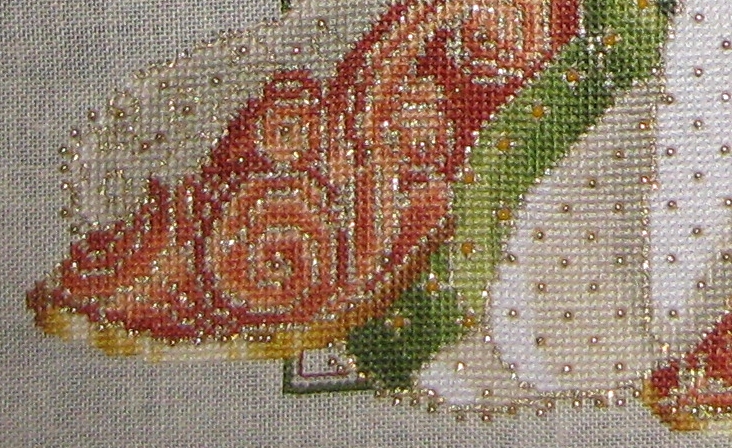Several people have emailed me for the full colour key list for stitching the Lavender and Lace Celtic Autumn in the alternative colours that I used. To make it clear, these colour choices weren’t my idea – I found the suggested colours on the Celtic Lady StitchA Long blog. If you’re interested in any of the five Celtic Ladies, this blog is wonderful, as it is a place for lots of stitchers to upload their progress photos. Sadly, the blog seems to have virtually ‘died’ now, but the images and text are still there as a really useful archive.
The colourway I used was listed on 3 June 2010 by ‘Little Cat’, if you want to find it by date on the blog. The only amendments I made when I stitched mine was that I used Petite Treasure Braid in shade PB03 instead of the suggested PB01. I used it straight as it came off the card, and in total I needed 3 cards of it, with just about 1/3 card left at the end (which I can use when I stitch the others in the series) 🙂
Here is the conversion:
Celtic Autumn – Changed Colours (DMC stranded cotton)
We have changed the colour of Celtic Autumn to orange and greens. You use the original copyrighted chart that Marilyn Leavitt-Imblum has designed. The symbols remain the same as on the original chart but you stitch with different colours. You may find it helpful to write the symbols on your thread card
Ecru = this remains the same
300 = this remains the same
301 = this remains the same
356 = this remains the same
400 = this remains the same
402 = this remains the same
644 = this remains the same
754 = this remains the same
758 = this remains the same
780 = this remains the same
781 = this remains the same
783 = this remains the same
822 = this remains the same
829 = use 936 instead
830 = use 937 instead
831 = use 469 instead
832 = use 470 instead
833 = use 471 instead
834 = use 472 instead
924 = use 610 instead
926 = use 612 instead
948 = this remains the same
3371 = this remains the same
3768 = use 611 instead
3776 = this remains the same
3820 = this remains the same
3822 = this remains the same
3823 = this remains the same
B5200 = this remains the same
2001 = use 3825 instead
2002 = use 922 instead
2003 = use 921 instead
2004 = use 920 instead
2005 = use 919 instead
2006 = use 918 instead
PB01 = use two of the three strands of gold instead
BEADS (Mill Hill)
Some of these have also been changed
5 = 00557 this remains the same
9 = use 00221 instead of 02009 – 2pks
4 = 02034 this remains the same
2 = 02093 this remains the same
3 = use 62020 instead of 03024
I hope that if you choose to make this lovely cross stitch design, you enjoy it as much as I did!
~~~~~~~~~~~~~~~~~~~~~~~~~~~~~~~~~~














